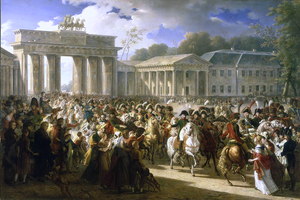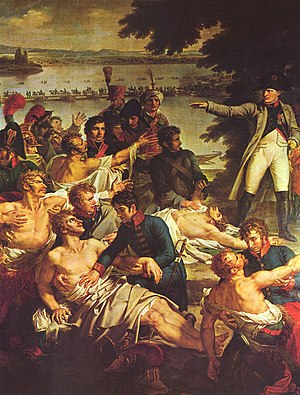Charles Meynier (born November 24, 1763 in Paris , † September 6, 1832 in Paris) was a French painter of the 18th and 19th centuries at the time of the Napoleonic Wars .
life and work Charles Meynier was born in Paris on November 23, 1763 and baptized the following day in the parish church of Saint Séverin . He came from a middle-class background. His father Jacques-Joseph Meynier was a Parisian horse dealer. He planned to train Charles Meynier as a tailor. But he was able to prevail against his father and go to a free drawing school. In this educational institution in Paris, which was only founded in 1767, he learned the basics of painting before taking an apprenticeship with the engraver Pierre-Philippe Choffard (1730–1809). Meynier continued to feel more drawn to painting, which his older brother Etienne Meynier supported. As a successful Comédie-Française actor , he financed his younger brother's apprenticeship in the studio of the famous painter François-André Vincent (1746-1816). In 1782 at the latest, Vincent became the teacher of Charles Meynier. Vincent got him enrolled at the Royal Academy of Painting and Sculpture in the same year . That changed nothing in terms of living conditions. Meynier still lived in his father's apartment building.
He won second prize in the Prix de Rome competition in 1789 . He designed the reliefs of the Arc de Triomphe du Carrousel in Paris . In 1816 he was elected to the Institut de France , where he (together with the classicists Antoine-Jean Gros , Louis Girodet-Trioson and Carle Vernet ) one of the four newly introduced seats ( Fauteuil XIII ) for the painting section of the Académie des Beaux- Arts held. One of his most famous paintings depicts Napoleon's entry into Berlin .
Meynier's works can be found in the Louvre in Paris , in the Palace of Versailles , in the Musée Magnin in Dijon and in the possession of the French Ministry of Finance . A major retrospective was shown in 2008.
In the art market, up to $ 536,000 was paid for his oil paintings.
Works (selection)
The world receives the laws dictated by nature, justice and wisdom from the emperors Hadrian and Justinian
(French: La Terre recevant des empereurs Adrien et Justinien le code des lois romaines dictées par la Nature, la Justice et la Sagesse)
Charles Meynier
Ceiling painting
511 × 324 cm
Louvre , Paris.
Napoleon Bonaparte as first consul
(French: Napoléon Bonaparte Premier Consul)
Charles Meynier
Oil on canvas
225 x 1.60 cm
Brussels City Museum
Marshal Ney, Duke of Elchingen, Prince of the Moscow River
(French: Le Maréchal Ney, duc d'Elchingen, prince de la Moskwa)
Charles Meynier
Oil on canvas
217 × 141 cm
Palace of Versailles
Cardinal Fesch, Archbishop of Lyon, Grand Chaplain of the Empire
(French: Le Cardinal Fesch, archevêque de Lyon, Grand aumônier de l'empire)
Charles Meynier
Oil on canvas
219 × 149 cm
Palace of Versailles
The soldiers of the 76th Line Regiment, who found their flags in the arsenal in Insbruck
(French: Les Soldats du 76 régiment de ligne, retrouvant leurs drapeaux dans l'arsenal d'Inspruck)
Charles Meynier
Oil on canvas
360 × 524 cm
Palace of Versailles
Napoleon's entry into Berlin, October 27, 1806
(French: Entrée de Napoléon à Berlin. 27 October 1806)
Charles Meynier
Oil on canvas
330 × 493 cm
Palace of Versailles.
Wisdom defends the youth from the arrows of love
(French: La sagesse préservant l'Adolescence des traits de amour)
Charles Meynier
Oil on canvas
242 × 206 cm
National Gallery of Canada
Napoleon's return to Lobau Island on May 23rd after the Battle of Aspern
(French: Retour de Napoléon sur l'île de Lobau le 23 may après la bataille d'Essling)
Charles Meynier
Oil on canvas
390 × 441 cm
Palace of Versailles.
literature Web links Individual evidence
↑ Isabelle Mayer-Michalon: Charles Meynier, 1763-1832. Arthena, Paris 2008, ISBN 978-2-903239-39-8 (French), p. 15
↑ Isabelle Mayer-Michalon: Charles Meynier, 1763-1832. Arthena, Paris 2008, ISBN 978-2-903239-39-8 (French), p. 16
↑ Académie des Beaux-Arts de l'Institut de France: SECTION I - PEINTURE / FAUTEUIL XIII (accessed on January 16, 2016)
↑ Information from the French museum database , accessed on March 10, 2012
↑ Information on thearttribune.com , accessed on March 10, 2012
↑ Information on the website of an international auction house , accessed on March 10, 2012
<img src="https://de.wikipedia.org//de.wikipedia.org/wiki/Special:CentralAutoLogin/start?type=1x1" alt="" title="" width="1" height="1" style="border: none; position: absolute;">








